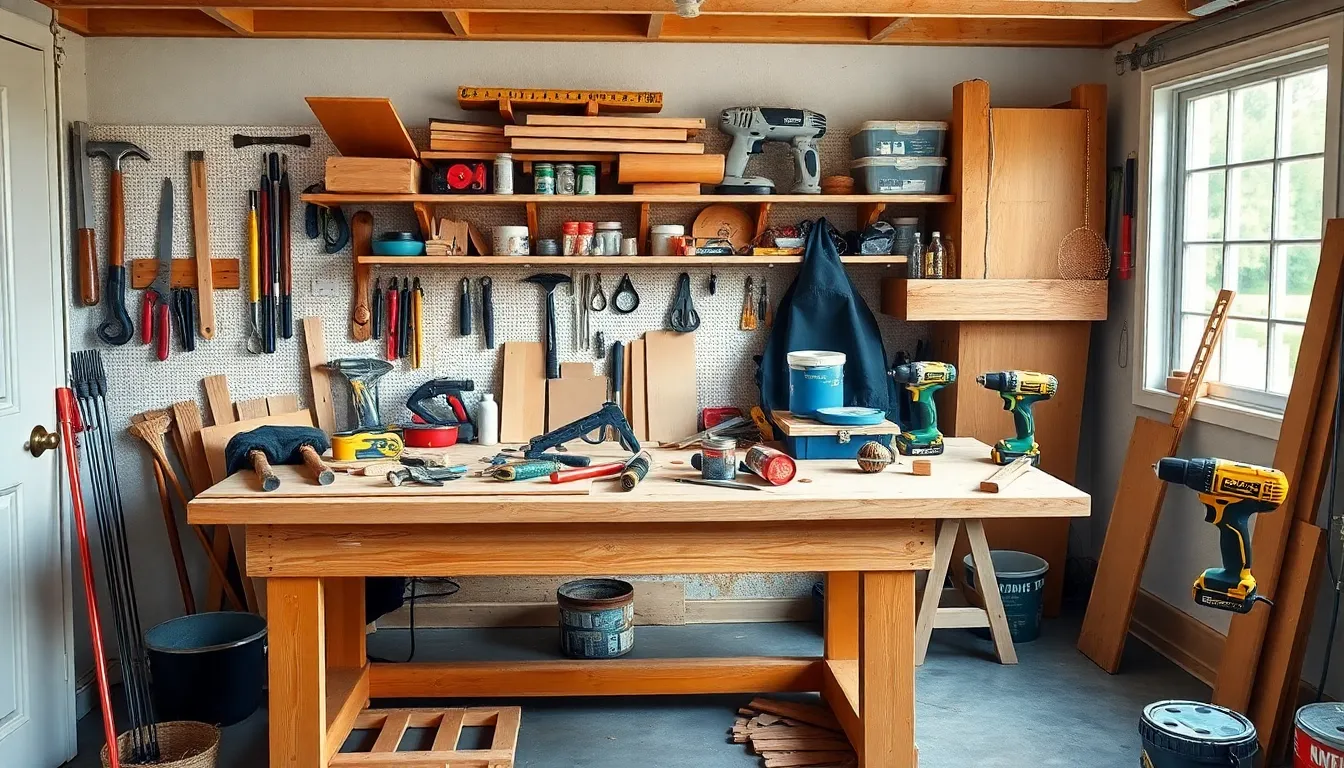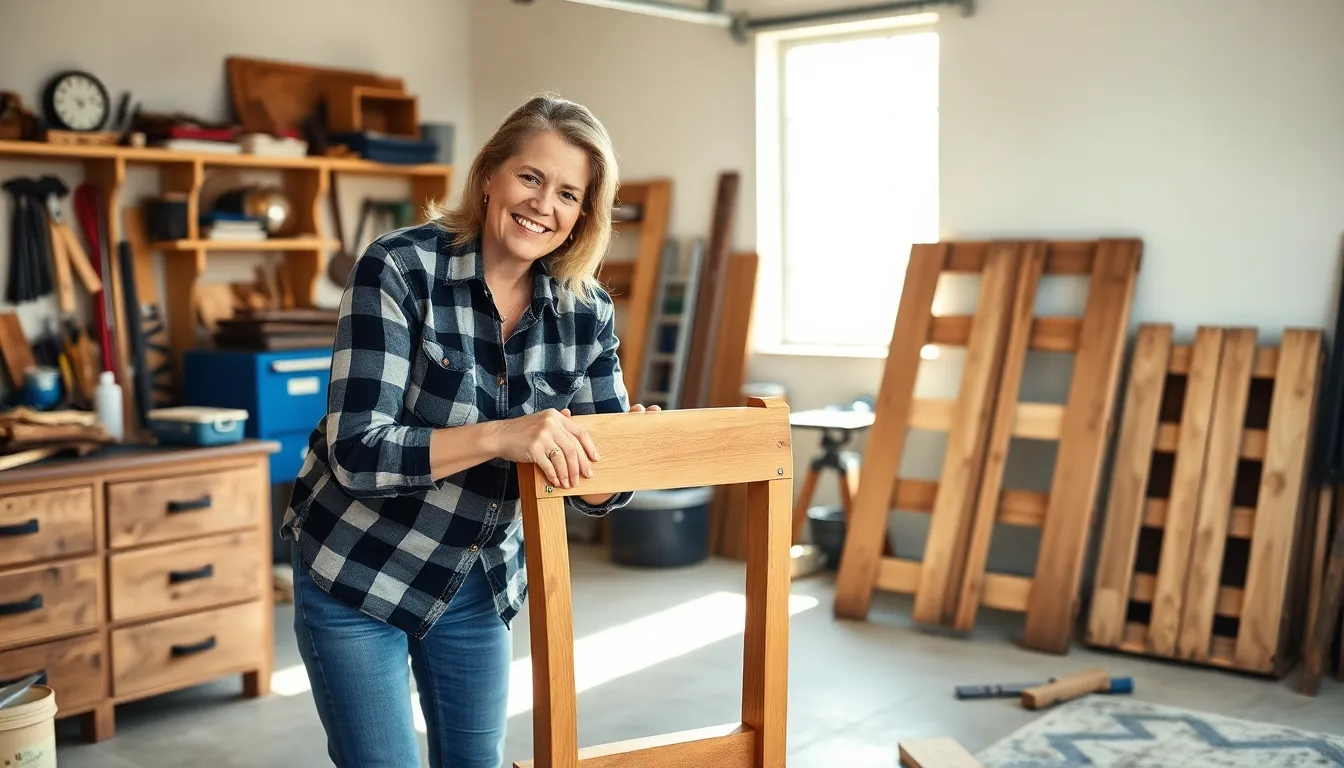In a world where creativity meets functionality, DIY home projects have become a popular way to transform living spaces. Whether it’s a simple weekend task or a more ambitious renovation, these projects offer a chance to personalize a home while saving money. With the right tools and a bit of inspiration, anyone can turn their vision into reality.
From crafting unique decor to tackling essential repairs, DIY projects empower individuals to take control of their surroundings. They not only enhance the aesthetic appeal of a space but also provide a satisfying sense of accomplishment. As more people seek ways to express their style and improve their homes, the DIY movement continues to thrive, making it an exciting time to dive into hands-on creations.
Table of Contents
TogglePopular DIY Home Projects
DIY home projects offer numerous opportunities for personal expression and creativity. Popular choices include furniture upcycling and garden enhancements that can amplify living spaces and outdoor areas.
Furniture Upcycling
Furniture upcycling involves transforming old or unused furniture into stylish, functional pieces. Techniques include sanding, painting, and reupholstering to give items a fresh look. Popular projects involve converting a wooden pallet into a coffee table, revitalizing an antique chair with new fabric, and creating a storage bench from an old dresser. Upcycled furniture reduces waste and adds unique character to living spaces.
Garden Enhancements
Garden enhancements focus on improving outdoor aesthetics and functionality. Common projects include creating raised garden beds, building decorative trellises, and designing outdoor seating areas. Using reclaimed materials like brick or wood for pathways adds texture and interest. Incorporating native plants not only beautifies but also supports local wildlife. Simple enhancements, such as installing a bird feeder or adding solar lights, can transform any garden into an inviting retreat.
Materials and Tools Needed

Gathering the right materials and tools is crucial for the success of DIY home projects. Using quality items enhances the outcome and simplifies the process.
Essential Tools for DIY Projects
- Measuring Tape: A measuring tape ensures accurate measurements for cutting and fitting materials.
- Level: A level helps achieve even surfaces and alignments, critical for furniture assembly.
- Screwdriver Set: A set of screwdrivers, including flat-head and Phillips, is essential for securing components.
- Hammer: A sturdy hammer drives nails into wood and assists in hanging items.
- Drill: A cordless drill simplifies tasks like making holes and driving screws.
- Saw: A hand saw or power saw provides precision for cutting various materials.
- Paintbrushes and Rollers: These tools are important for applying paint or finishes smoothly.
- Safety Gear: Safety goggles and gloves protect against dust, debris, and injuries.
Choosing the Right Materials
- Understanding Wood Types: Use softwoods like pine for lightweight projects and hardwoods like oak for durability.
- Selecting Paint or Stain: Choose interior or exterior paints based on project requirements and desired finishes.
- Evaluating Fabrics: Opt for durable fabrics suitable for upholstery, selecting based on color and texture.
- Considering Fasteners: Choose screws or nails that match the project’s material and weight load.
- Exploring Eco-Friendly Options: Consider sustainable materials like reclaimed wood and low-VOC paints for environmentally conscious projects.
- Budgeting: Assess costs for materials before purchasing, ensuring suitability for budget constraints and desired quality.
Step-by-Step Guides for Beginners
Engaging in DIY home projects includes simple repairs and creative decor endeavors. These step-by-step guides provide clear directions for beginners to successfully embark on their DIY journeys.
Simple Home Repairs
- Fixing a Leaky Faucet
Identify the type of faucet (compression, cartridge, or ball type). Gather an adjustable wrench, screwdriver, and replacement washers. Shut off the water supply, remove the faucet handle, and replace the worn washers or cartridges. Reassemble the faucet and turn the water back on.
- Patching Drywall Holes
Assess the size of the hole. Use joint compound for small holes or a patch for larger ones. Clean the area around the hole, apply a patch if necessary, and spread joint compound over the patch. After it dries, sand the area smooth and paint to match the wall.
- Repairing a Squeaky Door
Identify the source of the squeak by opening and closing the door. Use a silicone spray or a few drops of lubricant on the hinges. Open and close the door several times to distribute the lubricant evenly.
Creative Decor Ideas
- Creating a Gallery Wall
Gather a mix of framed art, photos, and decorative items. Arrange them on the floor to plan the layout before hanging. Use a level and tape measure to ensure even spacing and proper alignment on the wall.
- Upcycling Mason Jars
Clean and remove labels from mason jars. Paint or decorate them according to the desired style (rustic, modern, etc.). Use them as flower vases, utensil holders, or storage containers for small items.
- Making a Statement Headboard
Choose a material, such as plywood or upholstered fabric. Measure and cut the material to the desired headboard size. Attach it to the wall or bed frame using brackets, then add decorative touches like stencils or nailhead trim for a polished look.
Tips for Successful DIY Projects
Effective DIY projects require planning, organization, and adherence to safety. Implementing best practices enhances results while ensuring an enjoyable experience.
Safety Precautions
Safety remains paramount in any DIY endeavor. Utilizing personal protective equipment (PPE) minimizes risks during projects. Essential PPE includes:
- Safety goggles protect eyes from debris.
- Dust masks filter harmful particles in the air.
- Ear protection safeguards hearing during loud tasks.
- Gloves prevent cuts and abrasions while handling materials.
Reviewing tools for defects before use ensures they function correctly. Keeping workspaces tidy reduces accidents, while adhering to manufacturer instructions for tools and materials enhances safety. Proper ventilation is critical when working with paints and chemicals to avoid inhalation of harmful fumes.
Time Management Strategies
Managing time effectively contributes to smoother project execution. Establish clear goals by defining project scope and determining necessary tasks. Breaking projects into manageable segments creates a structured approach. Utilize the following strategies:
- Create a timeline by estimating the duration of each task, considering potential obstacles.
- Prioritize tasks based on complexity and skill level, starting with simpler tasks to build momentum.
- Set deadlines for each project phase to maintain progress while allowing for flexibility.
- Schedule regular breaks to rest and recharge, preventing burnout and maintaining focus.
Incorporating these time management strategies facilitates a more organized and efficient DIY workflow.
DIY home projects offer a fulfilling way to enhance living spaces while showcasing personal style. With a variety of projects available from furniture upcycling to garden enhancements there’s something for everyone. Engaging in these activities not only saves money but also fosters creativity and a sense of accomplishment.
By gathering the right tools and materials and following safety guidelines individuals can embark on their DIY journeys with confidence. Effective planning and time management further ensure success in these endeavors. As more people embrace the DIY movement they discover the joy of transforming their homes into unique reflections of themselves.




